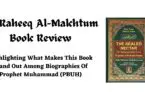The Forty Rules of Love is a novel written by Elif Shafak. The book was originally published on March 01, 2009. This is an interesting read with two ongoing stories side by side in different eras. In this write-up, we will go through a quick summary, review, and themes of the novel.
The Forty Rules of Love – Summary
“The Forty Rules of Love” is a novel by Elif Shafak that weaves together two parallel narratives. One is set in the 13th century during the life of the renowned poet Rumi, and the other in the present day, following Ella Rubinstein, a middle-aged woman searching for meaning in her life.
The story begins with a heart-wrenching incident of Ella getting cheated on by her husband. To move forward in life with this burden, she gets a new job as a reviewer. Her first task is to review the book, Sweet Blasphemy. It is the other part of the book has the story of the Shams of Tabriz and Maulana Rumi.
The story’s start can be summarized from the lines in the book, which encapsulate the idea that “Love has this quality to transform humans and allow them to see things differently.”
“Every true love and friendship is a story of an unexpected transformation. If we are the same person before and after we loved, that means we haven’t loved enough.”
Ella’s life takes an unexpected turn when she is assigned to read a manuscript titled “Sweet Blasphemy” by a mysterious author named Aziz Zahara.
As Ella delves into the manuscript, she becomes engrossed in the story of Rumi and his spiritual teacher, Shams of Tabriz.
The story of Rumi and Shams unfolds in the 13th century. Rumi, a respected Islamic scholar and preacher, encounters the eccentric dervish, Shams.
Initially skeptical of Shams’ unorthodox beliefs and practices, Rumi soon becomes deeply drawn to him and embarks on a transformative spiritual journey.
Through their intense friendship, Rumi learns to embrace love in its purest form, transcending societal norms and religious boundaries.
As Ella reads the manuscript, she becomes captivated by the profound teachings contained within the forty rules of love, which Shams imparts to Rumi.
These rules serve as a guide to embracing love and spirituality, challenging conventional notions of religion, and encouraging individuals to seek a deeper connection with themselves and the world around them.
Ella’s own life begins to mirror the spiritual awakening experienced by Rumi and Shams. She embarks on a personal journey of self-discovery. She questions her beliefs and reevaluates her relationships.
Through the transformative power of love and spirituality, Ella learns to find her own voice and follows her heart’s desires.
Ultimately, she breaks free from the confines of her unhappy marriage and pursues a life of fulfillment.
In short, “The Forty Rules of Love” is a tale of love’s transformative power, both in the past and the present. It beautifully explores the universal themes of connection, personal growth, and the search for meaning in life.
By intertwining the stories of Rumi and Ella, Elif Shafak invites readers to reflect on the profound impact love and spirituality can have on one’s life, reminding us of the timeless wisdom that lies within the forty rules of love.
On the one hand, where Rumi explores Sufism; Ella, on the other hand, explores true love.
The Love Ella felt for the Author of the book changed her. The friendship and devotion between the Shams of Tabraiz and Rumi made Rumi as we know him today.
Ella found how unhappy she was in her life and what she really wanted after feeling for Aziz. Rumi discovered his true poetic self after developing a bond with a mystic Sufi.
Elif Shafak’s book is an easy read, despite the oscillation between the two stories. They are separated by centuries but similar at their heart.
The prologue does give away a hint as to what the reader should expect.
“If a stone hits a river, the river will treat it as yet another commotion in its already tumultuous course. Nothing unusual. Nothing unmanageable. If a stone hits a lake, however, the lake will never be the same again.”
The Forty Rules of Love – Book Review
Every once in a while, in a discussion on “Love,” someone would end up recommending their top picks to read concerning the topic. “The Forty Rules of Love” by Elif Shafak would be there on the list.
The book has had such an impact on the readers because of its inherent simplicity.
Elif Shafak narrated two different stories of two different times set on different backdrops.
One is from the world of Sufism, where Rumi gets on the journey to find himself; discovers the layers of himself, and becomes the greatest Poet and Sufi of his time.
Another parallel story is of an unhappy housewife Ella; who happens to be a book reviewer professionally. Her first book in the line of work will change her perspective on “Love and Life” and her.
The story provides the readers with two love stories unfolding simultaneously; where the time is different, but what binds them together is Love.
The writer has tried to make forty a significant number for the female protagonist, and her life will change after it. The book has forty rules that surround both human and Sufi love.
Themes of the Novel
“The Forty Rules of Love” incorporates three themes: Love, Sufism, and feminism.
Ella, the main character, is the complete epitome of feminism. She is a woman who knows how to love herself and respect her choices.
Whereas we experience the Sufism theme throughout the novel in the spiritual friendship of Shams of Tabriz and Maulana Rumi.
The best part is this novel lets you experience two types of love; one is spiritual love and human love. You get to experience these two live side by side. It makes this novel a complete hit amongst its peers!
Symbols Used in the Novel
The book is divided into five parts; earth, water, wind, fire, and the void. These five constitute the universe; thus hinting at human emotions.
Each chapter is a crisp tale of the unfolding of the events taking place through narrations. Furthermore, they are set in different eras. One is happening in mid-thirteenth century Turkey. The other is in twenty-first-century America. Two very different worlds were trying to make sense of one common idea.
The track of Ella and Aziz that unfolds over their correspondence is rather slow and less gripping. The writer has tried to make it contemporary; yet conventional through the nuances and self-questioning thoughts. However, it didn’t spellbind me as the other track did.
Primarily, the character Ella narrates the track which makes it a little boring. The other track has characters besides the character of Shams of Tabraiz and Rumi. That’s riveting, to say the least. It keeps you hooked as to what Rumi’s family has to say and the characters like Sulaiman the Drunk, Desert Rose the Harlot, and Hasan the Beggar. It lets you see the world through people’s eyes that belong to different strata of the same society. They live very different lives while being in the same place and have opinions based on their individual experiences.
That’s the difference in narration and plot between the two stories, because of which the readers find the track of Shams of Tabraiz far more interesting than the track of Ella and Aziz.
The forty rules of love as the basic principles believed to be universal, dependable, and timeless are scattered throughout the book for the readers to comprehend as they like.
Everyone’s understanding of the rules might be different as to how they comprehend them. It can mean one thing to one individual and another to someone else.
It might leave a lasting impact on one and might not change a thing for the other, as that is the beauty of words. Hence, it strikes everyone differently. Words are so powerful that they can change a heart or pierce through it, touch souls, leave them untouched, heal them, break them, and allow everyone to have a rather personal association with them.
That is what the Forty Rules of Love can do to oneself and has done for many of its readers. It has liberated people of their fears, and doubts, and can transform one completely.
When I was a child,
I saw God,
I saw angels;
I watched the mysteries of higher and lower worlds. I thought all men saw the same. At last, I realized that they did not see.
The story moves smoothly. Moreover, it makes the reader a part of the journey that the main characters take to get to their true self.
Rumi learns and unlearns the ways of Sufism from the Shams of Tabraiz, who defy the usual. Rumi’s change was unfathomable for his family and the people who knew him, and the rest is history as well all know of it.
Ella found conviction in her own self; the courage to let go of the ways that weren’t making her happy. It comes down to what the person seeks and wants from his/her life.
Lessons Learnt from the Novel
As the rule mentioned above from the book talks about change. However, many of us are afraid of change. We spend all our lives living the ways of others right in front of us chosen for us by society and our families. We are hesitant about change and yet always are in search of it in worldly things.
“Try not to resist the changes that come your way. Instead, let life live through you. And do not worry that your life is turning upside down. How do you know that the side you are used to is better than the one to come?”
The Forty Rules of Love
One important message from the book is to always look inwards. We should try to explore ourselves first and foremost and then the world around us.
To find happiness, love, contentment, and meaning in this life, we would need to know what we truly want and are capable of. Every human being is different in this respect. What inspires one might not inspire another. What motivates one might not motivate the other. Similarly, what makes one happy might not make the other happy.
We all want to find love, but not many can give love in the truest sense it is devoid of any material or worldly gains.
If you would like to read something thought-provoking, insightful, and impactful; this novel is the right book for you.
After reading the book, your thoughts might be different from this review, which makes this book special for so many as it feels personal to its readers.
I would like to say bid with another rule from the book:
Let us choose one another as companions!
Let us sit at each other’s feet!
Inwardly we have many harmonies – think not
That we are only what we see.
The Forty Rules of Love – As mentioned in the Novel
Following are those forty rules of love that the author has taught us in the book. These forty rules of love serve as guiding principles for the characters in the novel, encouraging them to embrace love, spirituality, and self-discovery.
- How we see God is a direct reflection of how we see ourselves.
- The path to the Truth is a labor of the heart, not of the head.
- You can study God through everything and everyone in the universe because God is not confined to a mosque, synagogue, or church.
- There is only one religion, the religion of Love.
- Love is the only language that transcends all barriers.
- The whole universe is contained within a single human being.
- Everything in the universe is within you.
- What you seek is seeking you.
- The essence of all religions is one.
- The moment you accept what troubles you’ve been given, the door will open.
- The path to love requires open-heartedness and self-acceptance.
- To find true love, you must first find a true friendship within yourself.
- The real beloved is your own essential nature.
- The quest for love changes us. There is no seeker among those who search for love who has not matured on the way.
- Love is the water of life. And a lover is a soul of fire!
- Silence is the language of God, all else is poor translation.
- God is hidden in the hearts of all creatures.
- There are more fake gurus and false teachers in this world than the number of stars in the visible universe.
- Those who know, know that those who know nothing, know nothing.
- Love is the only reality and it is not a mere sentiment. It is the ultimate truth that lies at the heart of creation.
- Everything other than love for the most beautiful God is the agony of the spirit, though it is sugar-eating.
- Your task is not to seek love, but merely to seek and find all the barriers within yourself that you have built against it.
- The universe turns differently when fire loves water.
- The seeker of love escapes the chains of birth and death.
- When love arrives, every fear disappears.
- Attachment is not love. Love only exists in freedom.
- Love is the bridge between you and everything.
- The heart is the secret inside the secret.
- Not the ones speaking the same language, but the ones sharing the same feeling understand each other.
- East, west, south, or north makes little difference. No matter what your destination, just be sure to make every journey a journey within. If you travel within, you’ll travel the whole wide world and beyond.
- The midwife knows that when there is no pain, the way for the baby cannot be opened.
- The quest for love is like searching for the lost chord. The seeker of love runs toward the illuminating soul but finds only the ecstatic, bleeding heart.
- Before the throne of the Almighty, man will be judged not by his acts but by his intentions.
- Stay together, friends. Don’t scatter and sleep. Our friendship is made of being awake.
- The reason is powerless in the expression of love.
- There is nothing worse than being blind in the eye of the heart.
- The religion of love is the only religion.
- There is a force within us more powerful than any other. That force is love.
- The true Sufi is such that even when he is unjustly accused, attacked, and condemned from all sides, he patiently endures, uttering not a single bad word about any of his critics.
- Be grateful for every second of every day that you get to spend with the people you love. Life is so very precious.
You can buy “The Forty Rules Of Love” from Amazon







[…] Also Read: The Forty Rules of Love | Summary & Book Review […]